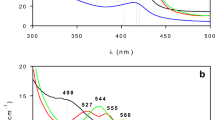Abstract
The thermal stability of a redox enzyme, bilirubin oxidase (BOD), has been quantitatively evaluated by measuring the inactivation kinetics of BOD at several temperatures. The enzyme activity is directly related to the mediated bioelectrocatalytic current for the BOD-catalyzed reduction of O2. Thus, the inactivation process is measured by the time-dependent decrease in the bioelectrocatalytic current. The results reveal that the inactivation obeys first-order kinetics, whose rate constants (k) are determined at pH 7.0 and at 50–70°C. The half life of BOD activity, calculated from the k value at 50°C is 114 min, which is in harmony with the thermal-stability data given in a catalog by Amano Enzyme Inc. The bioelectrocatalysis method allows in situ measurements of the inactivation kinetics in the period of a few minutes at relatively high temperatures. The rate constants show a large temperature dependence, leading to a large Arrhenius activation energy (EA) of 221 kJ mol-1. The activation Gibbs energy (ΔG≠), activation enthalpy (ΔH≠), and activation entropy (ΔS≠) are also determined.
Similar content being viewed by others
References
“Kouso Kougaku (Enzyme Technology, in Japanese)”, ed. S. Fukui, I. Chibata, and S. Suzuki, 1982, Tokyo-kagaku-dojin, Tokyo.
K. Kano and T. Ikeda, Bunseki (in Japanese), 2003, 576.
K. Kano and T. Ikeda, Electrochemistry, 2003, 71, 86.
“Baiodenkikagaku no Jissai—Baiosensa—Baiodenchi no Jitsuyou Tenkai (Practical Bioelectrochemistry—Recent Developments in Biosensors & Biofuel Cells, in Japanese), ed. T. Ikeda, 1982, CMC Publishing, Tokyo.
S. C. Barton, J. Gallaway, and P. Atanasov, Chem. Rev., 2004, 104, 4867.
T. Hibi and Y. Nishiya, p.101 in Ref. 4.
Thermal stability of enzymes is expressed as such in catalogs of enzyme companies. For example, the thermal stability of BOD appears in Amano Enzyme Catalog, 18 (http://www.amano-enzyme.co.jp/jp/productinfo/medical 03.html).
T. Ikeda, Chem. Rec., 2004, 4, 192.
S. Tsujimura, H. Tatsumi, J. Ogawa, S. Shimizu, K. Kano, and T. Ikeda, J. Electroanal. Chem., 2001, 496, 69.
S. Tsujimura, M. Fujita, H. Tatsumi, K. Kano, and T. Ikeda, Phys. Chem. Chem. Phys., 2001, 3, 1331.
S. Tsujimura, K. Kano, and T. Ikeda, Electrochemistry, 2002, 70, 940.
A. Shimizu, J. H. Kwon, T. Satoh, N. Sakurai, T. Sakurai, S. Yamaguchi, and T. Samejima, Biochemistry, 1999, 38, 3034.
T. Nakagawa, S. Tsujimura, K. Kano, and T. Ikeda, Chem. Lett., 2003, 32, 54.
A. Shimizu, J. H. Kwon, T. Satoh, N. Sakurai, T. Sakurai, S. Yamaguchi, and T. Samejima, J. Biochem., 1999, 125, 662.
S. Tsujimura, M. Kawahara, T. Nakagawa, K. Kano, and T. Ikeda, Electrochem. Commun., 2003, 5, 138.
R. Matsumoto, K. Kano, and T. Ikeda, J. Electroanal. Chem., 2002, 535, 37.
T. Ikeda, H. Tatsumi, H. Katano, and K. Kano, p. 38 in Ref. 4.
A. J. Bard and L. R. Faulkner, “Electrochemical Methods: Fundamentals and Applications”, 1982, John Wiley and Sons, New York, Chichester, Brisbane, Toronto, 457.
T. Ikeda, H. Tatsumi, H. Katano, and K. Kano, p. 43 in Ref. 4.
K. Hiromi, “Kouso Hannou Kaiseki no Jissai (Practice in Kinetic Analysis of Enzyme Reactions, in Japanese)”, 1982, Koudansya, Tokyo, 54.
T. K. Harris and V. L. Davidson, Biochem. J., 1994, 303, 141.
A. N. Eremin, D. I. Metelitsa, Zh. F. Shishko, R. V. Mikhailova, M. I. Iasenko, and A. G. Lobanok, Prikl. Biokhim. Mikrobiol., 2001, 37, 678.
M. D. Gouda, S. A. Singh, A. G. Rao, M. S. Thakur, and N. G. Karanth, J. Biol. Chem., 2003, 278, 24324.
D. N. Rani and T. E. Abraham, Appl. Biochem. Biotechnol., 2006, 128, 215.
S. Koikeda, K. Ando, H. Kaji, T. Inoue, S. Murao, K. Takeuchi, and T. Samejima, J. Biol. Chem., 1993, 268, 18801.
A. Shimizu, J. H. Kwon, T. Sasaki, T. Satoh, N. Sakurai, T. Sakurai, S. Yamaguchi, and T. Samejima, Biochemistry, 1999, 38, 3034.
Author information
Authors and Affiliations
Rights and permissions
About this article
Cite this article
Ikeda, T., Tatsumi, H., Katano, H. et al. A Bioelectrocatalysis Method for the Kinetic Measurement of Thermal Inactivation of a Redox Enzyme, Bilirubin Oxidase. ANAL. SCI. 24, 237–241 (2008). https://doi.org/10.2116/analsci.24.237
Received:
Accepted:
Published:
Issue Date:
DOI: https://doi.org/10.2116/analsci.24.237




